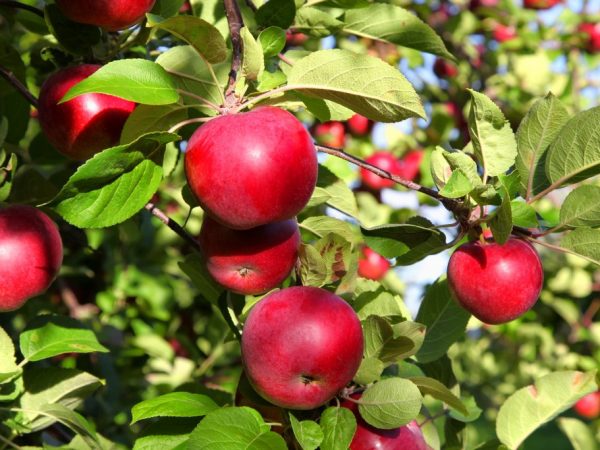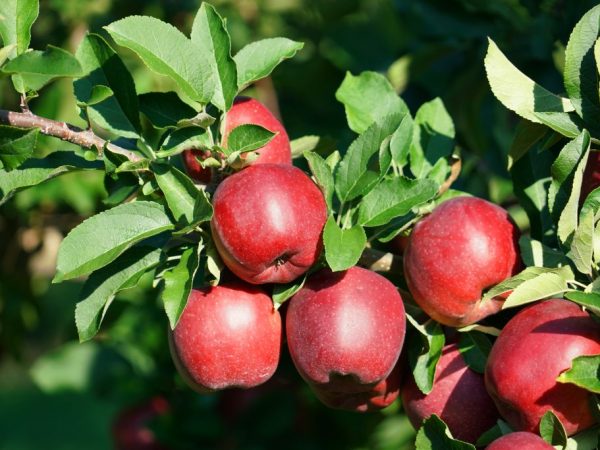Cultivation of apple-tree Belorussian sweet
Apple-tree Belorusskoe sweet is one of the most recognizable varieties of late winter fruit crops, which can be found in many garden plots.

Cultivation of apple-tree Belorussian sweet
Characteristics of a varietal culture
The apple tree was bred by Belarusian breeders at the beginning of 2000. The culture is characterized by rapid development - already in the 8th year after planting it can reach 3 m.
The crown is round, not particularly dense, drooping branches. This makes the care work much easier and is also an advantage when picking apples.
Varietal fruits are medium or large in size, their weight reaches 200 g. Appearance of apples is attractive: smooth, shiny skin is covered with a thick red blush over the entire surface. The pulp is snow-white in color and medium density.
Taste qualities
The taste qualities of apples are ambiguous due to the fact that they do not contain sourness at all. Some gardeners consider the taste of varietal fruits to be bland and monotonous. Their flesh is tender, with a subtle but persistent aroma.
Yield
The yield of the variety is high and stable. A large number of fruits annually make it possible to grow an apple tree for industrial purposes.
Already by the 5th year of fruiting, with good care, up to 35 kg of harvest can be harvested from one tree.
On dwarf rootstocks, fruiting is possible as early as next year. The yield is increasing rapidly.
Pollinators
The variety does not have to have a number of pollinators. It is pollinated by numerous insects, which are attracted by the sweet smell of flowering trees.
Winter hardiness
One of the essential advantages of the apple tree is its high level of winter hardiness. This allows it to be grown in regions with harsh climatic conditions, where frosts reach -35 ° C.
In colder regions, gardeners recommend insulating the culture before the onset of cold weather.
Disease resistance
The variety Belorusskoe sweet is resistant to various diseases: the natural immunity of the apple tree protects it from scab.
If there are a large number of fruit trees in the garden, gardeners recommend treating them for prevention.
Tree lifespan
Long-term fruiting. By creating favorable conditions for the culture, you will be able to receive annual harvests for 30 years. If the stock was made on low-growing plants, the lifespan of the tree is significantly reduced and reaches 20 years.
Landing

A sunny place is suitable for planting.
A place for planting a culture should be chosen sunny, protected from winds and drafts.
The apple tree is sensitive to excess moisture, so the groundwater should not be too close to the plant's root system.
Landing dates
It can be planted in early spring (before bud formation) or in late autumn (October - early November).
The second option is more common among gardeners due to the fact that by the spring the seedling will already take root and adapt to new conditions. Its root system will get stronger, so no additional plant care is required.
Landing technology
The process of planting a varietal tree includes certain stages.
- The hole must be dug 7-10 days before planting. This will give the soil time to dry out and compact. The size of the planting pit depends on the size of the seedling root system.
- It is recommended to loosen the bottom and mix the soil with wood ash. Additionally, you can add humus and superphosphate agents. It is necessary to pour some ordinary earth on top - this will prevent the roots of the plant from getting burned.
- The root system of the culture is straightened, after which the plant is placed in a planting pit. The hole is covered with soil so that the root collar of the apple tree is above the soil surface.
- After compacting the soil around the crop trunk, it is recommended to immediately carry out abundant watering (20-30 liters of cold water are poured under one plant). Moisturizing for a young tree is repeated every week.
Care
Watering an adult tree is recommended at least once every 30 days. In dry weather, it is increased up to 2 times a month. Moisten the soil under a young seedling more often - once a week.
In early spring, before the onset of budding of the culture, it is necessary to cut off the branches of the plant. This will help shape the crown as well as rid it of damaged, old, or dry branches. This will not give an opportunity to develop all kinds of fungal diseases. A similar procedure must be carried out in late autumn, after harvest (sanitary cleaning).
With the arrival of spring, the lower part of the tree trunk is whitewashed with garden lime. It is also used to process all fresh sections on the plant.
The variety is characterized by abundant flowering and a large number of ovaries. To prevent the fruits from becoming smaller, it is recommended, if necessary, to remove some of them. This will allow the fruit to develop qualitatively without harming the crop.
Top dressing
For higher yields, it is recommended to periodically feed the plant. For this, organic fertilizers, urea, and minerals are used. They should be introduced in autumn, early spring, during the period of ovary formation and fruit ripening.
Although the varietal crop is highly resistant to cold, for greater reliability, it is recommended to mulch the soil around the trunk of the plant before the onset of winter, and also take measures to protect it from the invasion of rodents (wrap the tree with protective material).
Features of ripening and fruiting

The crop must be harvested during
The fruits of the Belorusskoe Sweet variety are not prone to falling off, which allows you to preserve the integrity of the harvest until the very moment of its harvest, but it is important not to overexpose the apples on the tree, otherwise their keeping quality will significantly decrease. With the timely collection of fruits, they retain their qualities until the end of February.
If you use suitable rootstocks, the fruiting of the crop is accelerated - the harvest can be seen already in the first year of life.
Harvesting and storage
The fruits begin to ripen in early autumn (September-October). The timing may vary depending on the region of growth. In areas with a more severe climate, in contrast to warm zones, the onset of maturation is earlier, it begins already at the end of August.
You can eat fruits immediately after they are harvested, but experts say that fruits acquire the highest taste in January.
The crop is well stored in a wooden, air-permeable container, in a cool and dark room.Fruit should be inspected periodically; damaged fruit must be removed from the general container in order to prevent mass decay.
Subject to all conditions, the fruits can retain their qualities until the beginning of spring.
Growing in different climatic zones
The most favorable conditions for growing the variety are areas with a temperate climate. The Moscow region looks great.
Even in the Urals, with its difficult weather conditions and severe cold weather, it is possible to get good and stable harvests every year. It is important to carry out additional care, which consists in warming apple trees before the onset of cold weather.
The mild and temperate climate of Ukraine is also suitable for the normal, natural development and high fruiting of the Belarusian sweet apple tree.
Gardeners reviews
Experienced gardeners speak positively about the Belarusian sweet apple.
Among the main advantages are:
- early onset of fruiting (3-4 years after planting);
- high resistance to scab and diseases of the trunk bark;
- fruits are not prone to self-fall, have excellent taste and marketability, are easy to transport and are stored for a long time.
The annual abundance of the harvest is especially noted.
Among the relative disadvantages, the following are often distinguished:
- if improperly collected, the shelf life can be significantly reduced;
- sweet, without sourness, the taste of apples is not appreciated by all gardeners.

